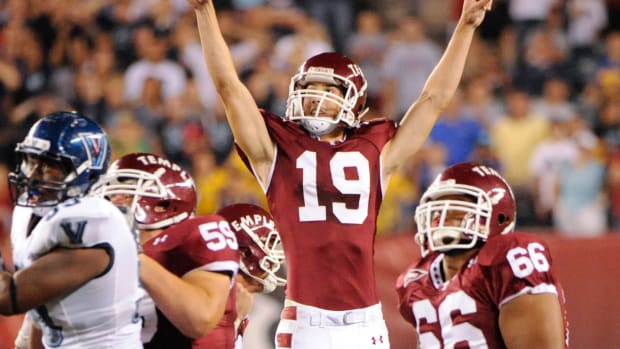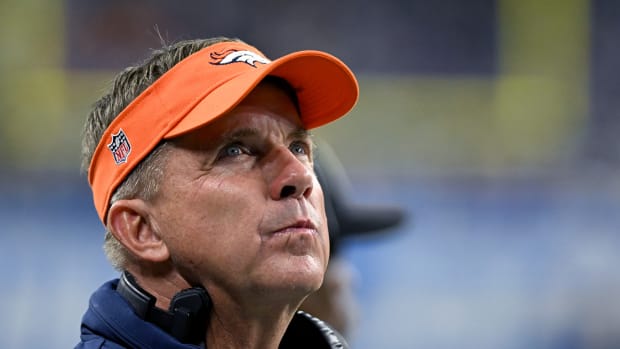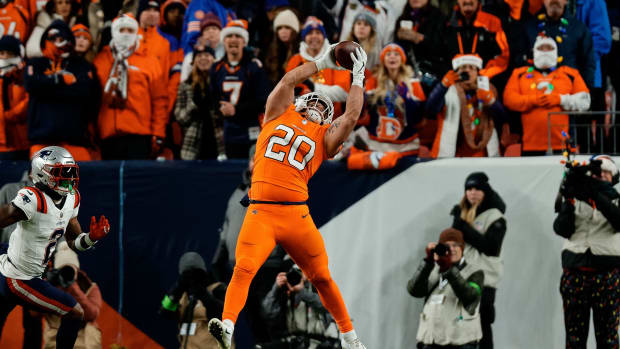This Answers Whether Broncos QB Russell Wilson is 'Washed'
Denver Broncos’ highly-paid quarterback Russell Wilson is struggling to start the season. There's no doubt about that, but is the prevailing sentiment correct?
Talking heads and fans say that Wilson is washed up, and some even claim he was never that good to begin with. These folks love to kick people when they're down, especially if they have a bone to pick or are green with envy.
The truth is, Wilson is an elite quarterback and is not washed up, even with his struggles in the first five games. How do we know this?
First, Wilson has proven he is an elite quarterback. Since 1960, there have been only 36 quarterbacks who have had at least four top-400 seasons (80th percentile) adjusted for era. Let that sink in.
Only 36 QBs ever achieved that feat out of the approximately 1,600 quarterbacking seasons that qualified for the analysis. Those 36 quarterbacks are the elite of the elite.
Wilson is one of those players.
One of only 36 since 1960. Hall-of-Fame quarterbacks like Dan Marino, Joe Montana, Johnny Unitas, and John Elway are on that list. In fact, 18 of the 26 eligible players are in Canton, so let’s put to bed the notion that Wilson was never a great quarterback.
Now, is he washed up? Obviously, he isn’t his old self, but it is far too early to answer definitively that he's washed. It would be very unwise to bet on it.
Of the 36 players who had at least four top-400 seasons, 24 have played at least four seasons at 33 years old or greater. I will deep-dive into those players, but first, let's examine the players who retired early or didn’t start at quarterback for at least four seasons.
Aging Elite QBs
Bob Griese called it quits after his top-400 season when he was 35 years old. He suffered significant injuries and decided to retire.
Boomer Esiason was the primary starter in Arizona at age 35, but when he returned for his second stint with the Bengals, he backed up Jeff Blake. Even though Esiason played in a few games that season and was effective, he retired when the season ended.
Brian Sipe had one the strangest reasons for not playing in the NFL after the season he played at 34 years old. He left for a big contract in the USFL. He didn’t play another down in the NFL after the USFL folded.
Although Daryle Lamonica played well in his top-400 season, he was 31 years old, and the starting job was given to Ken Stabler the next season. Lamonica left the game two years later.
John Hadl was a very good quarterback through his years, but his skills declined at age 34, and even though he hung around the league until he was 37, he was done starting at age 35.
Ken Anderson hurt his neck, and Esiason took over the starting duties. He held onto those duties with Anderson as a backup. Anderson last started at 35 years old.
Neil Lomax retired at age 30 due to a severely arthritic hip.
Roman Gabriel stuck around the league until he turned 37, but was not a starter after 35 because of nagging injuries and the fact that Dick Vermeil decided to go with youth at quarterback.
Tony Romo suffered a back injury at 34 years old and lost his job to Dak Prescott.
Trent Green was a starter until he was 35, but suffered from two major head injuries. People begged him to retire, but stuck around as a backup for two more seasons after his last starting stint.
Of these quarterbacks, only Lomax could not continue playing for at least two seasons after turning 33. The most predominant reason for their inability to play past 35 years old was a significant injury.
Elite QBs at 33-Plus
Now, let's dive into the 24 quarterbacks who did play at least four seasons at age 33 or greater. Those quarterbacks are Elway, Roger Staubach, Billy Kilmer, Steve Young, Drew Brees, Ben Roethlisberger, Matt Ryan, Fran Tarkenton, Philip Rivers, Sonny Jurgensen, Aaron Rodgers, Joe Montana, Dan Fouts, Warren Moon, Bart Starr, Len Dawson, Jim Kelly, Tom Brady, Kurt Warner, Peyton Manning, Brett Favre, Johnny Unitas, Dan Marino, and Stabler.
13 of these quarterbacks’ seasons were in the top-20 greatest of all time, adjusted for era. Four are in the top-5. That is an elite company.
Elway is the quintessential example of playing incredibly well late in a career. His peak season happened at age 33, and his final six seasons were in the top-400.
Those seasons were only 7% lower on average than Elway's peak campaign. That's incredible play in the twilight of a quarterback’s career. He was also lucky not to suffer significant injuries when he was finishing his career.
Staubach was not far behind. His peak season was at age 31, and his five seasons at 33 plus were all in the top-400 and were only 8% off from his peak. He declined an offer from the Dallas Cowboys to keep playing and retired at 37, still playing at a high level.
Eight of the 24 quarterbacks had their peak season at 33 or older, and all but three had at least one top-400 season at 33 or older. 10 had at least four more seasons in the top-400, and more than half of them had a decline from their peak season of less than 20%.
What this points to is that elite quarterbacks are typically elite for at least four seasons after turning 33 years old.
There are a few on this list whose play declined, at least from their peak season. The average of Manning’s seasons after turning 33 was 23% lower than his peak season. However, that doesn’t tell the entire story.
Manning's peak season at age 28 was the third-greatest of all time. With a peak that good, it is difficult to come close to that performance again.
However, Manning's season at age 37 was the sixth-greatest of all time. Even though he had a severe neck injury, he played at a high level until he was 38.
Brady is another who had such a high peak that it would be difficult to repeat. His peak was second-greatest all time, so it's understandable that his average at age 33 and beyond is 23% less.
Brady has still had a whopping nine seasons in the top-400 after turning 33. That's incredible.
There are a few quarterbacks who found it difficult to repeat their past successes. The most notable is Marino. He is the owner of the greatest season of all time, adjusted for era.
Get your Broncos tickets from SI Tickets HERE!
That occurred when Marino was only 23 years old. He had some great seasons after that, but he ruptured his Achilles and had to wear a special shoe while he played when he was 32 years old. Even though he played well for two seasons after, he was mostly a shell of his former self from ages 35 to 38.
Stabler had a similar path to Marino. He had the fifth-greatest QB season all-time at age 31, a good season at age 34, and then a massive decline mostly due to significant injuries that he had sustained.
We can go down the list of the other quarterbacks that declined due to major injuries. Fouts, Dawson, and Unitas all had injuries to their knees, Moon fractured his shoulder, and Favre had a long list of significant injuries that would affect his ability to throw the football.
The interesting part of this analysis is that even though these elite quarterbacks had major injuries that impacted their performance, almost all of them still had great seasons after turning 33 years old.
What it Means for Wilson
Why is all of this important to understand when looking at Wilson and his future? First of all, his elite status is well-established. It's highly unlikely that he is all of a sudden washed up. Most players who called it quits early were doing so due to significant injuries.
Second, Wilson will likely have multiple seasons that could fall into the top-400 of all time after coming to Denver. Finally, he has not suffered significant injuries in his career that would hasten his decline.
Last season, Wilson had his first career injury. He missed only three games due to surgery on the finger of his throwing hand. Will this injury begin to bother him as he ages? It's possible, but it does not appear to be the issue in 2022.
Wilson still has significant velocity on his throws, and his accuracy has to do with timing, not a flaw because of the injury. It has been reported that he has a partial tear in his latissimus dorsi of his throwing shoulder, but that happened in the Week 4 game in Las Vegas. This would indicate that his issues prior to the injury were not physical.
Contributing to Wilson's inaccuracy, on paper at least, is the number of drops by his receivers. It's been reported that the Broncos lead the league in dropped passes.
If 75% of those drops were caught, Wilson’s numbers would look significantly better. In fact, his completion percentage would increase from 59% to approximately 64%.
Bottom Line
Wilson is not in decline due to age or injuries at this point in his career. He is struggling, but it isn’t physical.
Wilson is more likely to produce multiple great seasons before he retires than a rapid drop-off. He needs to find his rhythm, and the rest of the Broncos' offense must do its part.
If that happens, we will all witness a large turnaround and a lot of crow being eaten.
Follow Thomas on Twitter @ThomasHallNFL.
Follow Mile High Huddle on Twitter and Facebook.
Subscribe to Mile High Huddle on YouTube for daily Broncos live-stream podcasts!






